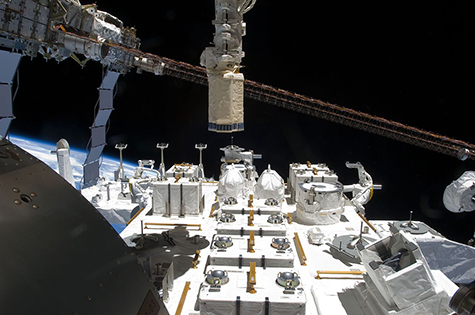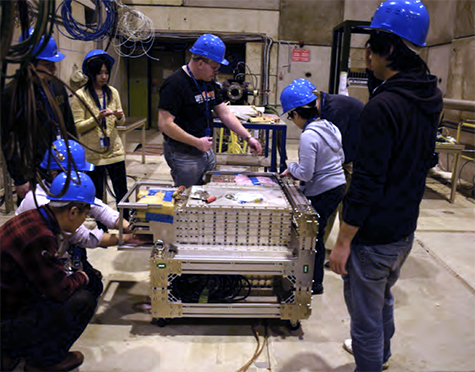
If everything goes according to plan, on Wednesday, Aug. 19, at 6:45 a.m. St. Louis time, NASA TV will broadcast the launch of a cargo container at the Tanegashima Space Center off the southern coast of Japan. In addition to water and spare parts, the cargo container will carry CALET, an astrophysical observatory designed to study the high-energy cosmos.
When the cargo craft reaches the space station four days later, a robot arm will install CALET on the “exposed facility” of the Japanese Experiment Module, where it will begin recording arrivals of cosmic rays–high-energy electrons, protons, and bare atomic nuclei–as well as gamma rays, in an effort to solve several cosmic mysteries.
CALET’s main goal is to use high-energy electrons to find nearby cosmic ray sources, but, thanks to work by Brian Rauch, PhD, research assistant professor in physics in Arts & Sciences at Washington University in St. Louis, an important secondary goal will be to count rare ultra-heavy nuclei, long of particular interest to Washington University astrophysicists.
“To really understand the origin of cosmic rays, it would be best if we had the whole periodic table mapped out,” said Martin Israel, PhD, professor of physics in Arts & Sciences. “The relative abundance of iron and everything lighter has been well measured, but the heavier elements are so rare that a typical detector only sees a few, and we don’t have good statistics on them.”
A Japanese mission, CALET has both an Italian and a U.S. contingent. The U.S. team, led by Louisiana State University, includes Washington University, the NASA Goddard Space Flight Center and the University of Denver.
Washington University was invited to join the collaboration partly because of longstanding friendship between Shoji Torii of Waseda University in Japan, CALET’s principal investigator, and W. Robert Binns, PhD, research professor of physics in Arts & Sciences at Washington University. Torii, Binns and Israel worked together on a proposal in the 1980s and have stayed in touch ever since.
The U.S. principal investigator John Wefel of LSU also has a Washington University connection. He earned his doctorate under Michael Friedlander and Robert Walker at the university in 1971.
Quarry 1: local cosmic ray sources
Much of the history of cosmic-ray research could be characterized as an attempt to get above Earth’s atmosphere so that scientists could know they were looking at the cosmic rays themselves and not at the debris left when they slammed into the nucleus of an atom in the air and broke apart.
This is why cosmic-ray experiments are typically carried aloft by stratospheric balloons — where the data must still be corrected for air-nucleus collisions — or shot in space. Washington University has a long history of lofting both balloon-borne and space-based instruments.
The primary science mission of CALET is to measure the variation in the abundance of electrons with energy. Structure in this spectrum can identify nearby cosmic bodies that are acting as particle accelerators.
Supernova explosions are the only objects thought capable of supplying the energy required to accelerate cosmic rays, and yet scientists have yet to “see” particles escaping from these stellar convulsions. The high-energy electrons should help identify their sources less ambiguously.

“Because electrons are very light particles,” Binns explains, “they scatter easily and lose energy quickly as they travel through the galaxy. So any high-energy electrons we detect near Earth had to originate fairly close to us.”
CALET, which stands for CALorimetric Electron Telescope, was designed to absorb and measure the full energy of these electrons. High in the detector, electrons will undergo impacts in thin tungsten sheets, creating giant showers of particles that will then travel through logs of material that completely stop these secondary particles, forcing them to deposit their energy within the detector, Binns explains.
“We don’t expect the electron spectrum to be smooth,” he said. “We expect it to have bumps that might be related to individual supernova remnants. For example, there might be electron bumps corresponding to the nearby supernova remnants Monogem, Vela and Cygnus Loop.”
The expected source signatures are at energies above the range of any other instrument except CALET, Binns said. CALET is able to resolve electrons with extraordinary energies (in the TeV range, or more than 1012 electron volts) because it is a brick of an instrument, a thick stack of sheets and logs of dense scintillating material (see photo below).
Target of opportunity: ultra-heavies
Washington University’s preflight contribution to CALET has been to help with simulations of the instrument’s response to different types of particles. “Simulations give you a template,” Binns explains, “so that in space you can recognize the type of particle and its energy from its penetration depth and the shape of the shower it produces in the detector.
“To validate the simulations we take the detector to CERN, the particle accelerator in Switzerland,” said Rauch, who has been on three accelerator runs. “At the accelerator we shoot a known particle of a known energy at a known spot on the instrument, collect the data, and then run a simulation of the same event, to make sure it matches.”

“A mindboggling amount of physics goes into these simulations,” he said, “and that’s why the beam runs are indispensible. With anything that complex, there’s also a chance that you missed something.”
Rauch made another contribution to the mission, as well. CALET was originally designed to detect and distinguish electrons, gamma rays and atomic nuclei lighter than iron. But Rauch was able to show that CALET would see a significant number of nuclei heavier than iron, if they employed a trick to identify them.
‘Ultra heavies,’ as Rauch calls them, are extremely rare. “How many you see depends on the area you can expose, and CALET is a smaller instrument than our balloon-borne instruments Tiger and Super-Tiger,” he said. “If the nuclei had to go through the entire thickness of the instrument, we wouldn’t see many.
“But I was able to show that we could count ultra heavies that arrived at glancing angles and went through just the top layers of the instrument if we used the Earth’s magnetic field to exclude low-energy particles, whose charge is harder to determine.
“If we continually calculate the cutoff on particle energy imposed by the local magnetic field, we can select only those particles with energies high enough that their charge doesn’t have to be corrected for their energy. Using this trick we can collect three or four times more particles than we would if we counted only those that hit the detector square on.
“We’ll be looking at ultra heavies with higher energies than people have been able to observe before, and their relative abundances may also help to identify the cosmic accelerators,“ Rauch said.
Asked which of the possible science results he would most like to see, Rauch, who cut his teeth on balloon-borne missions as an undergraduate at Washington University, hesitated for a moment. “I’m just glad to finally be in space,” he said.